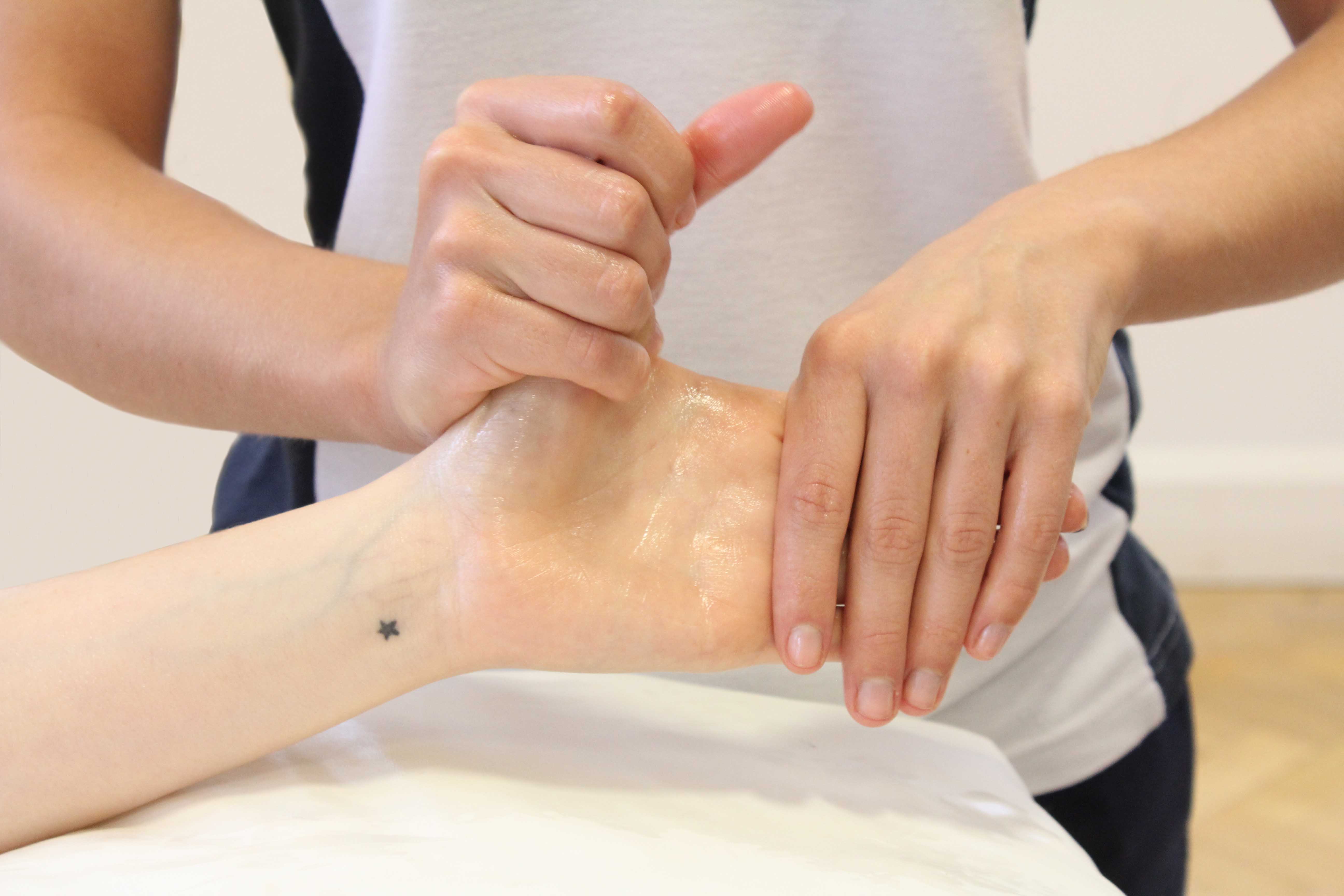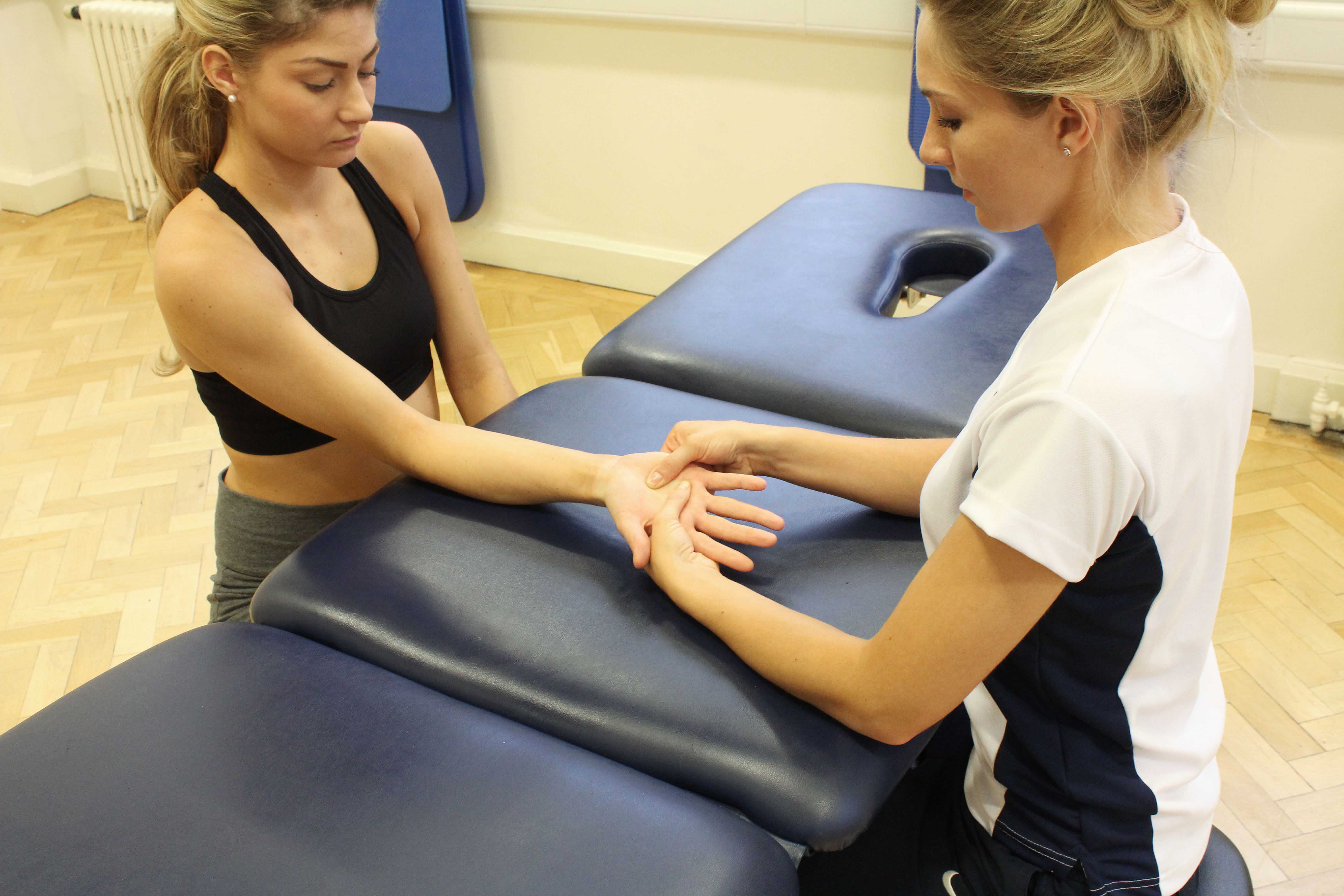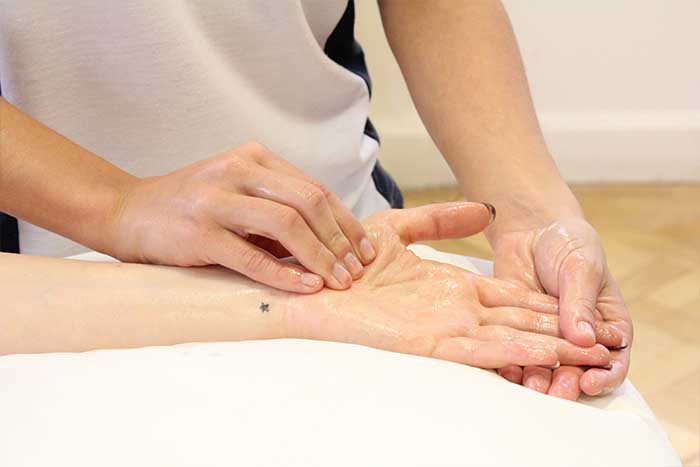A hand massage focuses on the muscles located within the hand. There are many muscles that make up the hand. The main muscles are the flexors and extensors. Flexor muscles include; flexor carpi radialis, flexor carpi ulnaris and the flexor pollicis longus. Extensor muscles include; extensor carpi radialis brevis, extensor carpi radialis longus and the extensor carpi ulnaris. A hand massage involves using a wide range of techniques to achieve benefits such as decreased tension and swelling. Massage therapists at Physio.co.uk use a hand massage to help decrease pain, increase relaxation and decrease scarring.
What techniques are used in a hand massage?
Many techniques are used during a hand massage. The most common techniques used in a hand massage include:
 Above: Soft tissue massage of the hand
Above: Soft tissue massage of the handFrictions can be used during a hand massage. Fingertips and thumbs are used to apply pressure along muscle fibres. Frictions can be used to decrease restriction within the hand. Restriction can be a result of a build-up of collagen fibres after injury. The circular movement used during frictions increases the temperature of the collagen fibres. Increasing the temperature of collagen fibres reduces restriction by increasing its elasticity and allowing it to stretch. Decreasing restriction caused by collagen fibres also helps to decrease pain.
Trigger pointing is a common technique used within a hand massage. Trigger points can be found in the centre of muscle fibres and often cause pain if not treated. A hand massage involves applying pressure to the trigger points to soften and break them down. Trigger points are broken down as an ischemic reaction occurs. An ischemic reaction is where blood flow is restricted due to the pressure being placed upon the trigger point. As the pressure is realised an increase in blood flow is encouraged to the area. An increase in blood flow helps to keep the muscles strong and healthy by providing them with an increase of oxygen and nutrients.
Skin rolling is often used during a hand massage. Skin rolling involves the skin being picked up and rolled between the fingers and thumbs. Skin rolling can be used to reduce pain by decreasing muscle and fascia tightness. Fascia is a layer of tough connective tissues located beneath the skin. Muscles and fascia often cause tightness due to a decrease in elasticity. An increase in blood flow helps to raise muscle and fascia temperature to increase elasticity. Increasing the elasticity decreases restriction and therefore pain.
Acupressure is a technique used during a hand massage. Acupressure is where pressure is applied to specific areas on the hand using the fingertips or thumbs. Acupressure helps to increase blood flow to the hand and break down muscular knots. An ischemic reaction occurs when acupressure is performed. An ischemic reaction occurs as blood flow is restricted to the area as pressure is applied. When pressure is applied to the specific areas of the hand, muscular knots begin to break down and a reduction in restriction can occur. As the pressure is released, an increase in blood flow is encouraged to help repair any damaged cells and keep the muscles healthy.

When can a hand massage help?
There are many different ways a hand massage can help. Situations where a hand massage can help include:
 Above: Soft tissue massage of the palma fascia in the hand
Above: Soft tissue massage of the palma fascia in the handHow does a hand massage help acute pain?
Acute pain can be reduced through a hand massage. Acute pain can be caused by many things including overuse and injury. Nerves in the body are what create a feeling of pain. Nerves create pain when they receive a message from the brain to do so. Pain receptors in the skin are what send a signal to the brain to make it aware that damage has occurred.
A hand massage aims to reduce acute pain by increasing muscle temperature and disturbing the signal sent from the receptors to the brain so that nerves do not get the message to create a feeling of pain.
A hand massage can increase muscle temperature. Friction created between the skin and fingers encourages an increase in blood flow. An increase in blood flow rises muscle temperature. When temperature rises, muscles relax as elasticity is increased. Relaxation of muscles decreases pain as restriction is reduced.
During a hand massage, the skin and hands create friction. The friction created produces a new signal. The new signal created disturbs the signal that is sent to the brain making it aware the damage has occurred. Disturbing the original signal can result in the nerves not creating a feeling of pain due to not receiving a message from the brain to do so. Disturbing the signal sent to the brain can therefore reduce pain.
How does a hand massage help post-surgery?
Surgery can have negative effects on the body. Due to a decrease in range of movement that is allowed, muscles often become tight and tense resulting in an increase in pain.
A hand massage aims to decrease effects of surgery by relieving tightness and tension.
Muscle tightness is caused by a decrease in elasticity within muscular tissue. Inelastic muscular tissue creates restriction that can contribute towards an increase in pain. A hand massage decreases tightness by increasing the temperature of muscular tissues to allow them to relax and increase in elasticity. Increasing the elasticity decreases muscle tightness and decreases pain.
Tension is caused by a muscle staying contracted. When muscles stay contracted, they are unable to relax which can further increase restriction and pain. As muscle temperature increases due to an increase in blood flow, muscles relax. Relaxed muscles decrease tension and pain.
How does a hand massage help relaxation?
A hand massage can encourage relaxation. A hand massage can help relax the body both physically and mentally.
A hand massage aims to encourage relaxation by relieving tension and increasing the relaxation hormones called serotonin and dopamine.
Blood flow is improved during a hand massage. An increase in blood flow rises muscle temperature. Rising muscle temperature reduces restriction and allows the muscles to relax therefore decreasing tension. Decreasing tension helps to physically relax the body.
A hand massage can also encourage psychological relaxation. Cortisol is a stress hormone found within the body that decreases levels of relaxation. A hand massage decreases the levels of cortisol and replaces this with relaxation hormones, serotonin and dopamine. Serotonin and dopamine are both hormones secreted from the brain. A hand massage encourages the release of both hormones. Increasing serotonin and dopamine enables a person to mentally relax and can also give a sense of well-being.

How does a hand massage help scarring?
Scarring can be reduced by a hand massage. Scars are a result of damaged skin that has occurred after injury. When skin has been damaged, a build-up of scar tissue occurs to bring together damaged fibres. Scar tissue is made up of collagen fibres. Collagen fibres are not as elastic as our skin so can become restrictive.
A hand massage aims to reduce scarring by loosening scar tissue to reduce restriction and realign collagen fibres to reduce the appearance of scars.
Friction created between the hands and skin increases blood flow. An increase in blood flow rises tissue temperature. A rise in tissue temperature allows an increase in elasticity and flexibility. An increase in elasticity and flexibility reduces restriction.
As scar tissue is loosened, collagen fibres are encouraged to realign. Realigning collagen fibres reduces the appearance of scars as they become aligned with our own fibres.
What are the benefits of a hand massage?
Many benefits are gained through a hand massage. Benefits gained include:
How does a hand massage decrease tension?
Decreased tension is a benefit achieved through a hand massage. Tension is created when muscles contract and do not relax. Tension can restrict movement and cause pain if not treated.
A hand massage aims to relieve tension by loosening and relaxing contracted muscles.
The temperature of muscles rises during a hand massage due to an increase in blood flow. An increase in muscle temperature allows muscle to stretch and increase in elasticity. Allowing muscles to stretch helps them to relax and get them out of the state of contraction. An increase in elasticity reduces restriction to help decrease pain.
How does a hand massage improve recovery?
A hand massage can help improve recovery. After injury or surgery, the effects can often be damaging.
A hand massage aims to improve recovery by improving blood circulation and stimulating the lymphatic system.
Blood circulation is improved during a hand massage. The friction created between the skin and hands encourages an increase in blood flow. A hand massage helps the muscle tissue surrounding the blood vessels to relax to allow an increase in blood to flow through them. An increase in the amount of capillaries also occurs to provide the muscles with more oxygen and nutrients. Providing the muscles with an increase of oxygen and nutrients helps to repair damage and keep muscles strong and healthy.
The lymphatic system is stimulated during a hand massage. The lymphatic system aids in the removal of metabolic wastes that could be slowing down recovery. Metabolic wastes are removed through lymph vessels in the lymph flow. A decrease in metabolic wastes also keeps muscles strong and healthy. Stimulation of the lymphatic system can also reduce swelling. Swelling is caused by a build-up of metabolic waste, most commonly found around the wrist area. Increasing the removal of metabolic wastes through lymph flow helps to reduce swelling and decrease pain.
How does a hand massage reduce swelling?
Reduced swelling is a common benefit gained through a hand massage. There are many causes of swelling, the most common being surgery and injury. After surgery or injury, the body tries to fix damage by increasing blood flow. However, capillaries tend to be more permeable after injury or surgery, meaning that white blood cells and plasma are able to leak out and surround the damaged area. Swelling is a result of a build-up of these fluids and other metabolic wastes.
A hand massage aims to reduce swelling by repairing damaged blood and lymph vessels.
After injury or surgery, blood and lymph vessels become damaged, resulting in inefficient cellular exchange. Cellular exchange is the removal of metabolic wastes that are replaced with oxygen and nutrients. Damaged blood and lymph vessels allow a build-up of fluids. A hand massage encourages the body's natural healing process to speed up. The body's natural healing process then quickly starts to repair damaged vessels. An increase in healthy blood and lymph vessels allows metabolic wastes and fluids to be removed through the lymph flow and healthy nutrients to be increased through the blood flow. Removing excess fluid and metabolic wastes results in a reduction of swelling.
How does a hand massage break down scar tissue?
A hand massage can help break down scar tissue. Scar tissue is made up of fibrous collagen fibres and is formed after an injury has occurred. Scar tissue is often restrictive resulting in muscle tightness and pain.
A hand massage aims to loosen scar tissue to relieve tightness and pain.
During a hand massage, an increase in blood flow occurs. An increase in blood flow increases the temperature of the scar tissue temperature. Increasing the temperature of scar tissues allows them to stretch and increase in elasticity. Collagen fibres that make up the scar tissue realign, reducing restriction and therefore muscle tightness. A reduction in muscle tightness reduces pain.
Summary
A hand massage focuses around the muscles located within the hand. A variety of techniques are used during a hand massage such as frictions, trigger pointing skin rolling and acupressure. The different techniques used help to decrease acute pain, reduce the effects of surgery, increase relaxation and decrease scarring. A hand massage provides many benefits to a person including decreased tension, improved recovery, reduced swelling and the breakdown of scar tissue. Our massage therapists at Physio.co.uk effectively use a hand massage to reduce pain and increase relaxation.
How can I arrange a hand massage?
The easiest way to arrange a hand massage at Physio.co.uk is to email us at office@physio.co.uk or call us on 0800 033 7800.
Alternatively if you have any questions please feel free to contact us.
We offer a 7 day service and provide home and clinic appointments.

 0330 088 7800
0330 088 7800



































